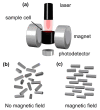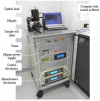Laboratory evaluation on the sensitivity and specificity of a novel and rapid detection method for malaria diagnosis based on magneto-optical technology (MOT)
- PMID: 20642834
- PMCID: PMC3224991
- DOI: 10.1186/1475-2875-9-207
Laboratory evaluation on the sensitivity and specificity of a novel and rapid detection method for malaria diagnosis based on magneto-optical technology (MOT)
Abstract
Background: This study describes the laboratory evaluation of a novel diagnostic platform for malaria. The Magneto Optical Test (MOT) is based on the bio-physical detection of haemozoin in clinical samples. Having an assay time of around one minute, it offers the potential of high throughput screening.
Methods: Blood samples of confirmed malaria patients from different regions of Africa, patients with other diseases and healthy non-endemic controls were used in the present study. The samples were analysed with two reference tests, i.e. an histidine rich protein-2 based rapid diagnostic test (RDT) and a conventional Pan-Plasmodium PCR, and the MOT as index test. Data were entered in 2 x 2 tables and analysed for sensitivity and specificity. The agreement between microscopy, RDT and PCR and the MOT assay was determined by calculating Kappa values with a 95% confidence interval.
Results: The observed sensitivity/specificity of the MOT test in comparison with clinical description, RDT or PCR ranged from 77.2 - 78.8% (sensitivity) and from 72.5 - 74.6% (specificity). In general, the agreement between MOT and the other assays is around 0.5 indicating a moderate agreement between the reference and the index test. However, when RDT and PCR are compared to each other, an almost perfect agreement can be observed (k = 0.97) with a sensitivity and specificity of >95%.
Conclusions: Although MOT sensitivity and specificity are currently not yet at a competing level compared to other diagnostic test, such as PCR and RDTs, it has a potential to rapidly screen patients for malaria in endemic as well as non-endemic countries.
Figures



References
-
- Mens PF, Spieker N, Omar SA, Heijnen M, Schallig HDFH, Kager PA. Molecular biology the best alternative for diagnosis of malaria to microscopy? A comparison between microscopy, antigen detection and molecular tests in rural Kenya and urban Tanzania. Trop Med Int Health. 2007;12:238–244. - PubMed
-
- Reyburn H, Mbita R, Drakely C, Carneiro I, Mwakasungula E, Mwerinde O, Saganda K, Shao J, Kitua A, Olomi R, Greenwood BM, Whitty CJ. Overdiagnosis of malaria patients with severe febrile illness in Tanzania: a prospective study. BMJ. 2004;329:2121. doi: 10.1136/bmj.38251.658229.55. - DOI - PMC - PubMed
-
- World Health Organization/FIND. Malaria rapid diagnostic test performance: results of WHO product testing of malaria RDTs: round 1. WHO, Geneva; 2008.
Publication types
MeSH terms
Substances
LinkOut - more resources
Full Text Sources
Other Literature Sources
Medical

